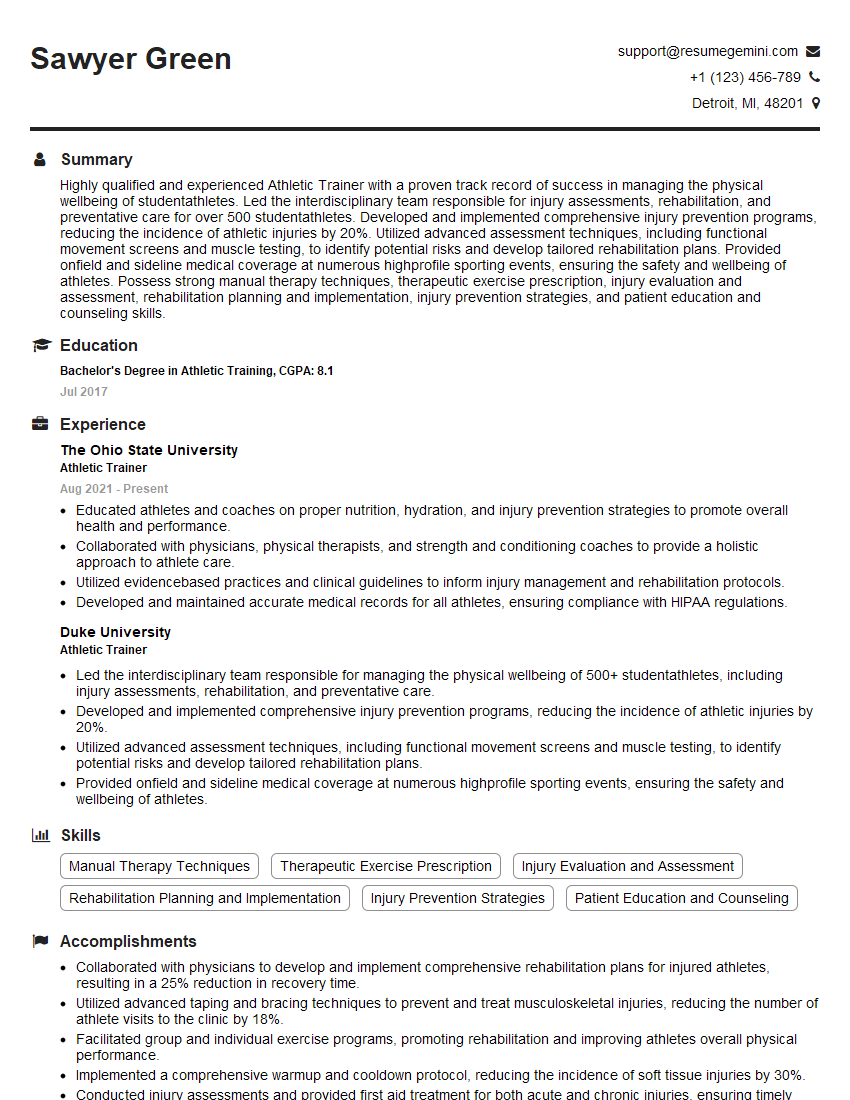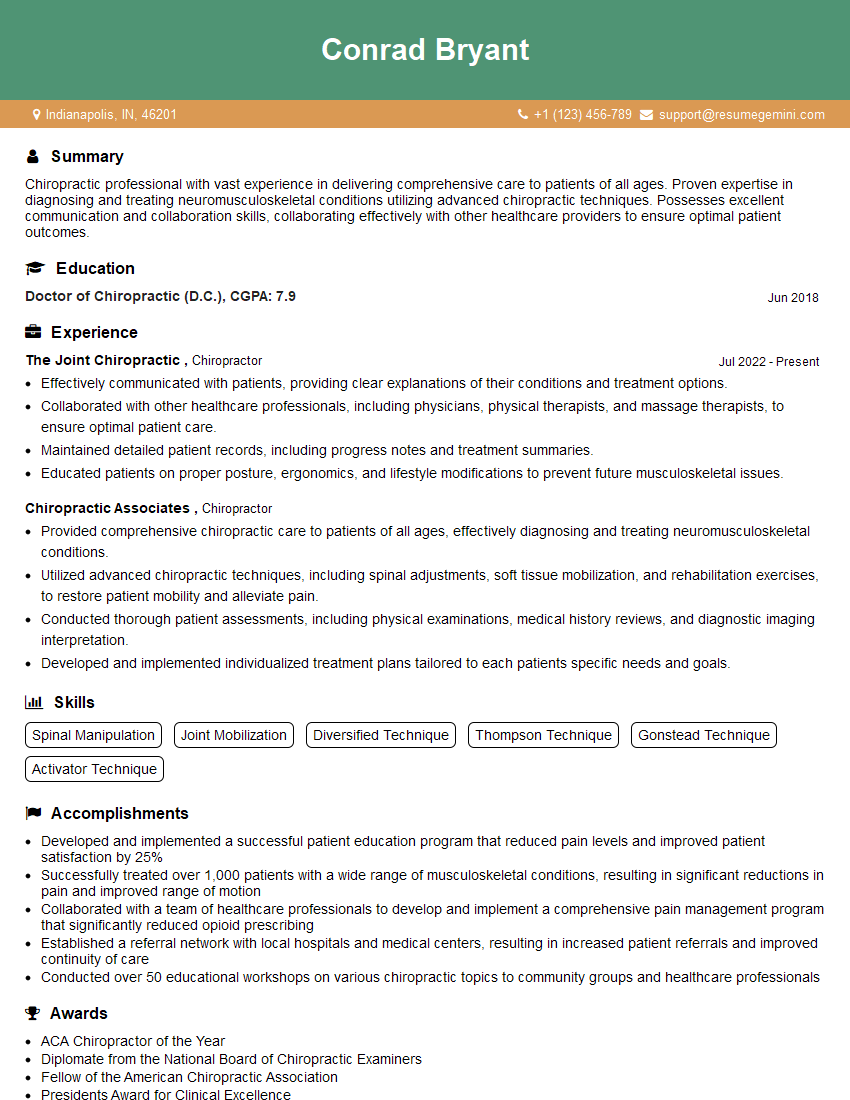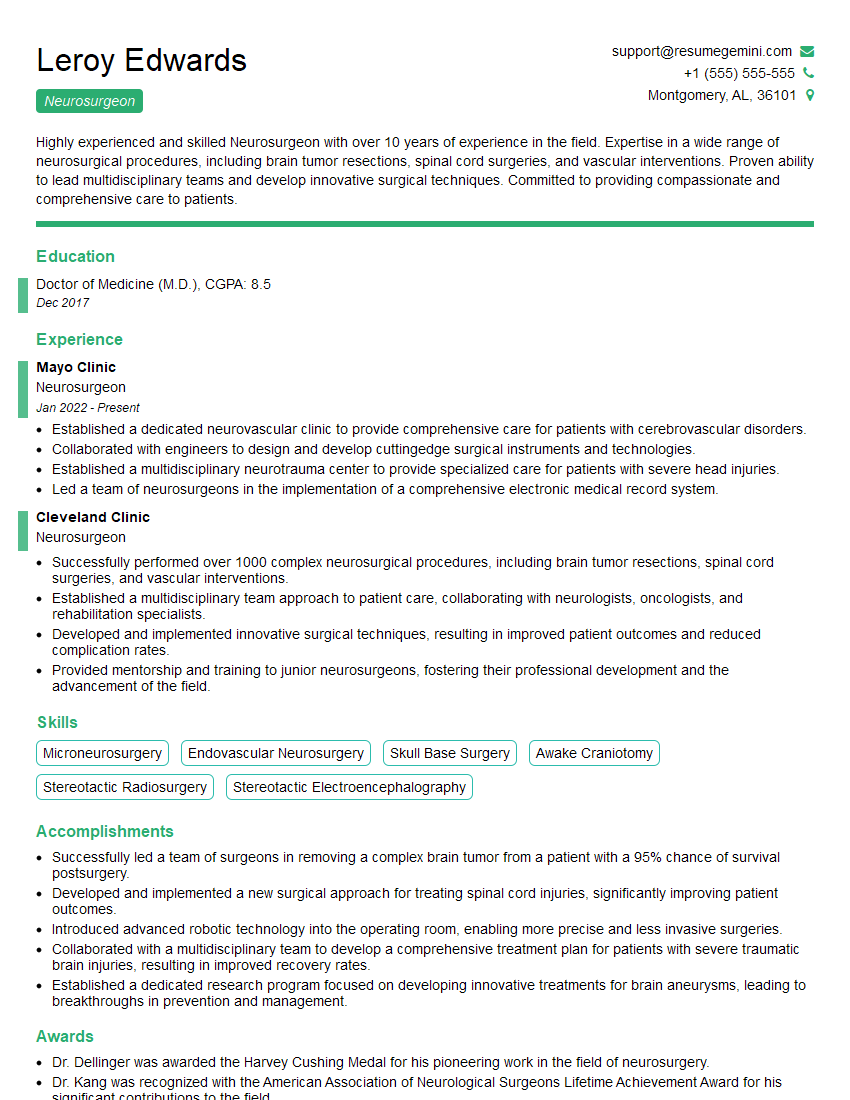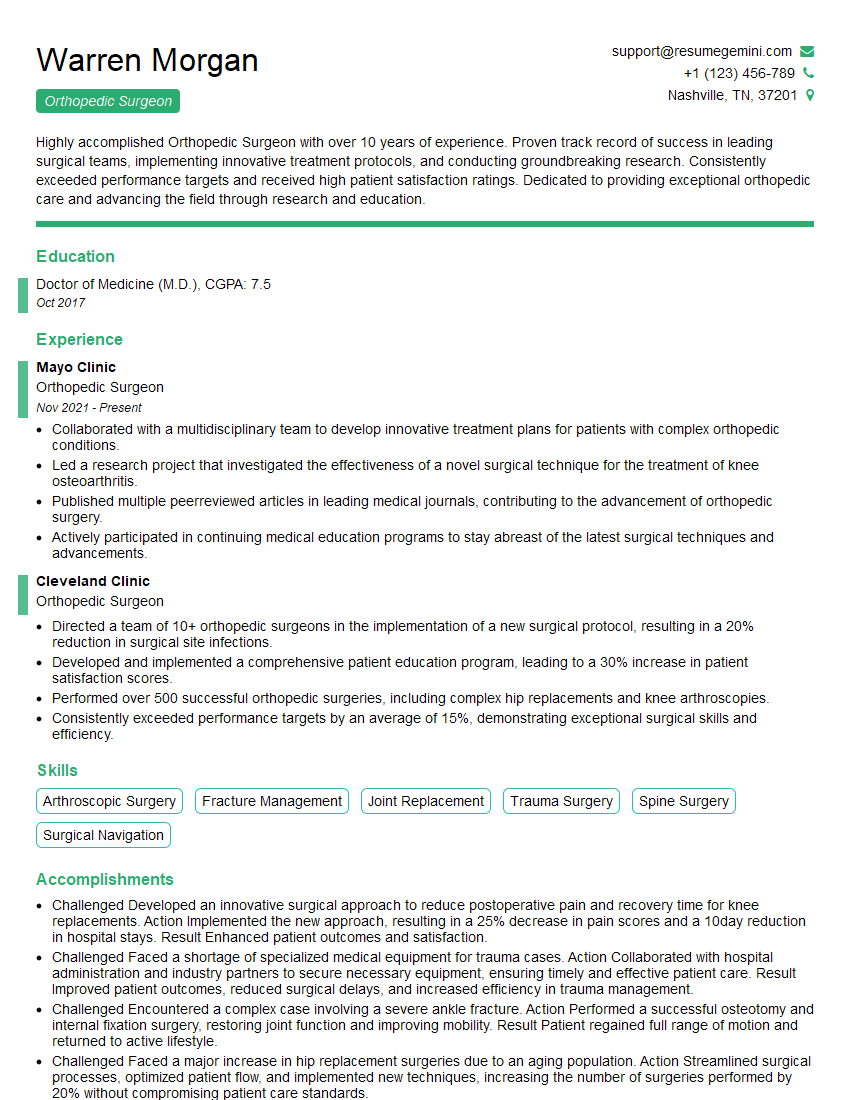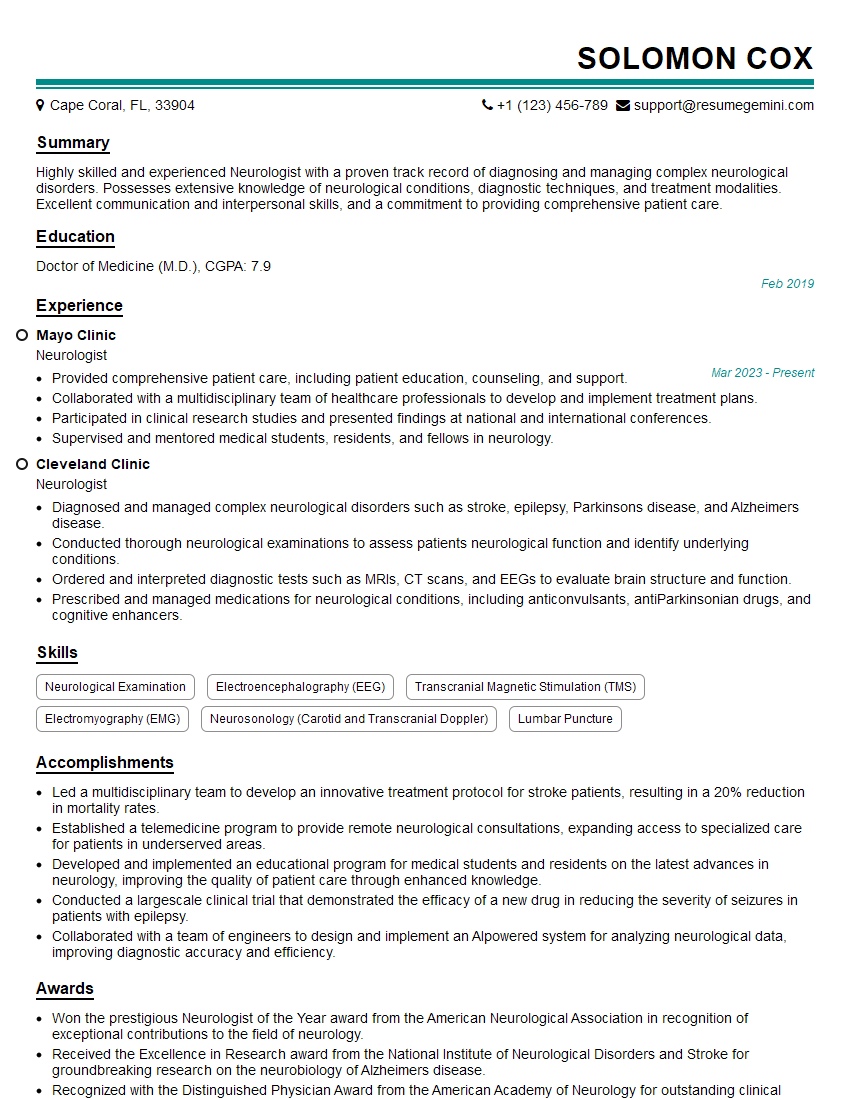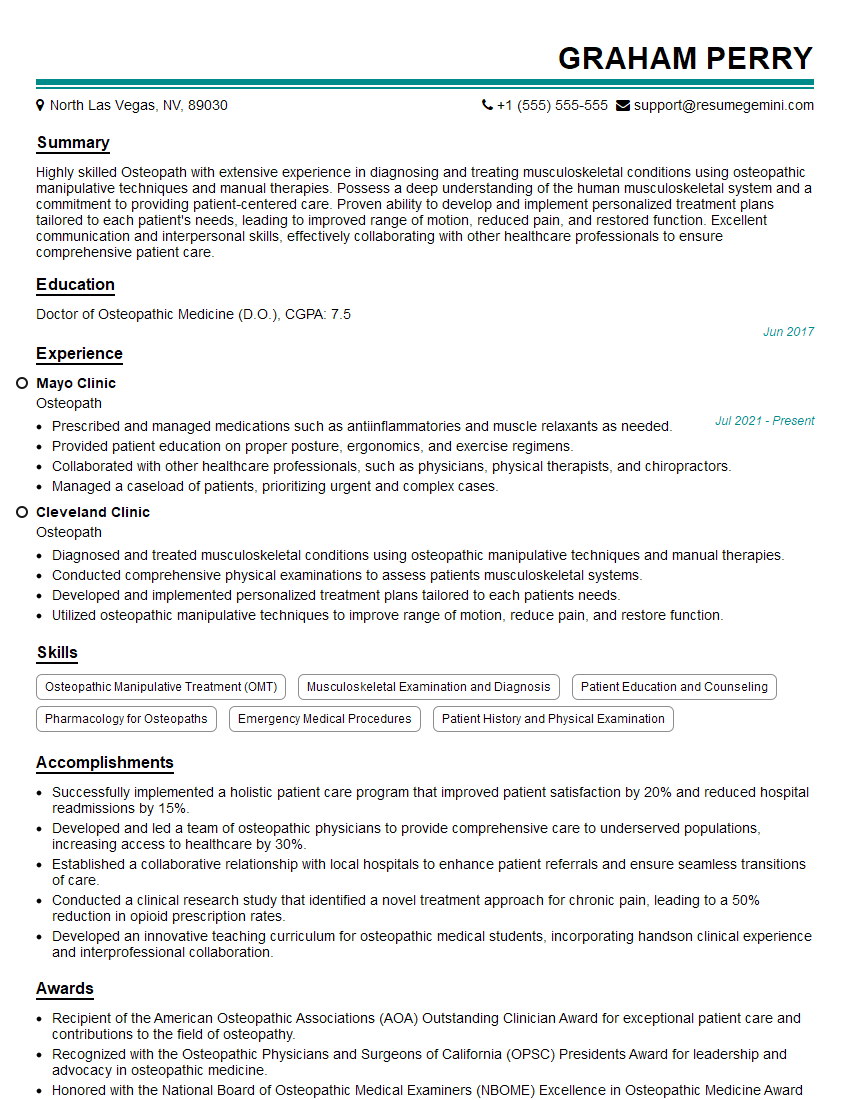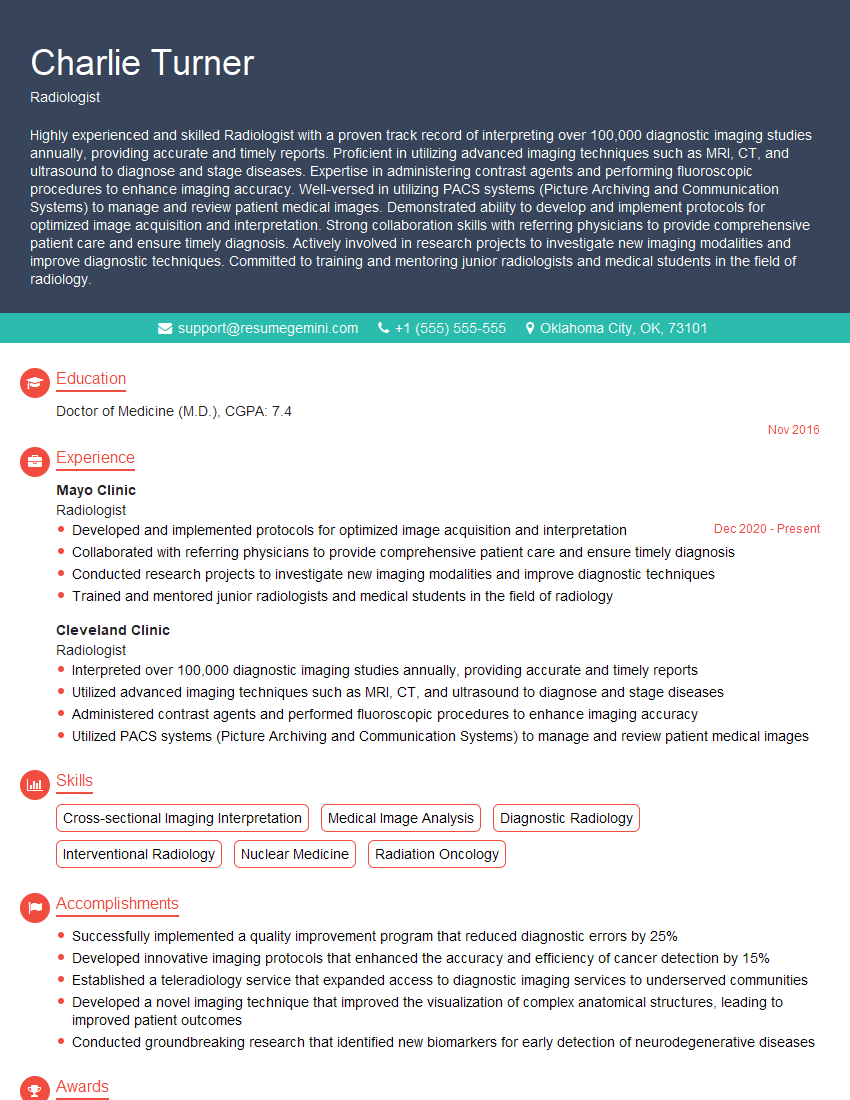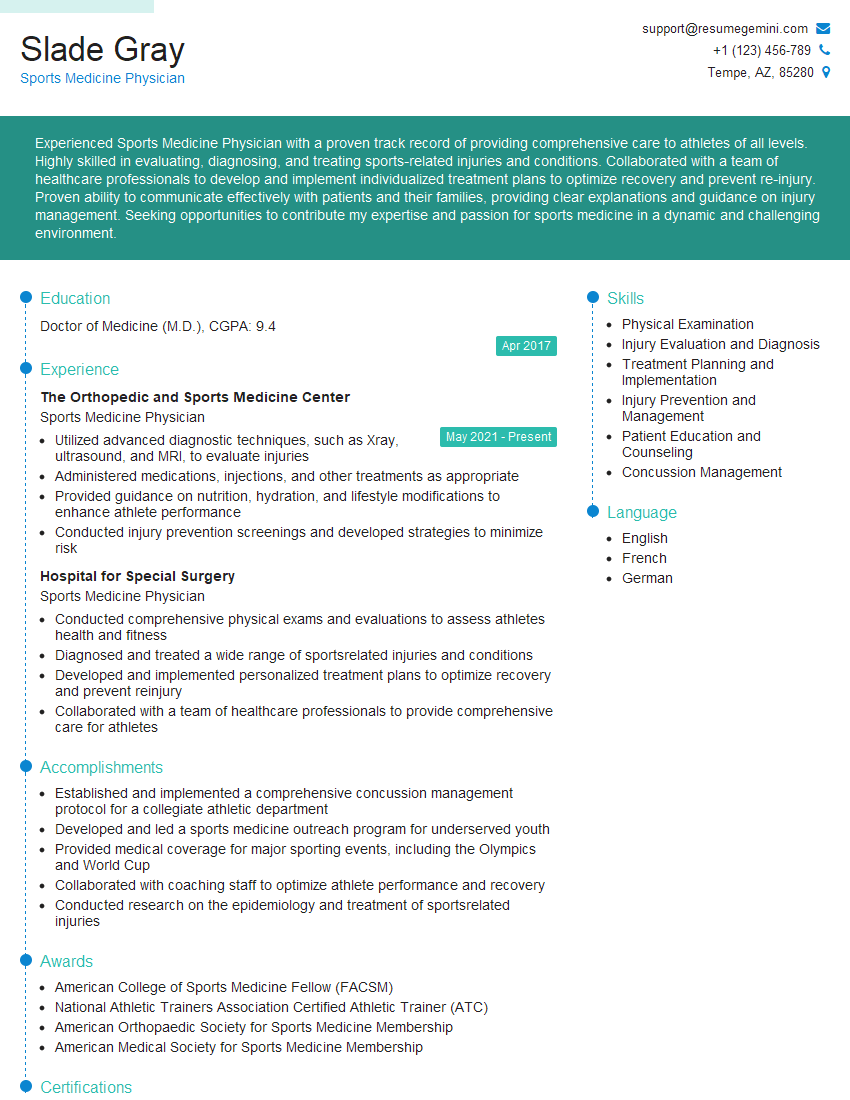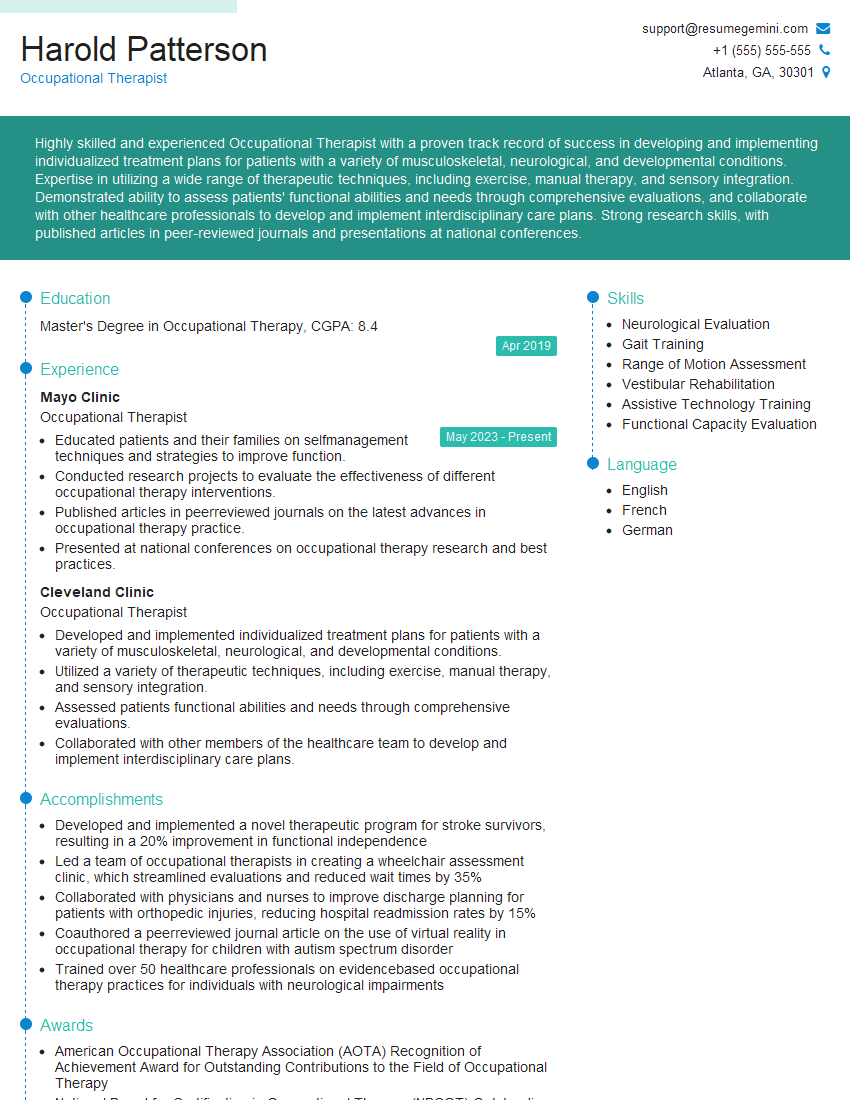The thought of an interview can be nerve-wracking, but the right preparation can make all the difference. Explore this comprehensive guide to Kyphosis interview questions and gain the confidence you need to showcase your abilities and secure the role.
Questions Asked in Kyphosis Interview
Q 1. Describe the different types of kyphosis.
Kyphosis, or hunchback, is broadly classified into different types based on its cause, severity, and location. It’s not just one condition; it’s an umbrella term.
- Postural Kyphosis: This is the most common type, often seen in adolescents. It’s usually caused by poor posture and is not associated with underlying structural abnormalities of the spine. Think of a teenager slouching – that’s a classic example. It’s generally correctable with posture exercises and strengthening.
- Scheuermann’s Kyphosis: This is a more serious structural kyphosis that develops during adolescence. It’s characterized by wedging of the vertebrae, leading to a rounded upper back. The exact cause isn’t fully understood, but genetics and growth spurts are implicated.
- Congenital Kyphosis: This type is present at birth due to abnormalities in the development of the spine. It can range in severity, from mild to severely disabling. Early diagnosis and intervention are crucial.
- Kyphosis due to other conditions: Kyphosis can also be a secondary effect of other conditions like osteoporosis (weakening of bones), infections (like tuberculosis), tumors, or trauma. It’s essential to identify the underlying cause to treat the kyphosis effectively. For instance, a compression fracture from osteoporosis can lead to a noticeable kyphosis.
Q 2. Explain the typical diagnostic process for kyphosis.
Diagnosing kyphosis involves a multi-step process that combines a thorough physical examination with imaging studies.
- Physical Examination: A doctor will assess posture, examine the spine’s range of motion, and check for any muscle weakness or pain. They’ll also look for neurological signs to rule out any nerve compression.
- Imaging Studies: X-rays are the primary imaging modality. They provide a clear picture of the spine’s curvature, allowing measurement of the angle of kyphosis ( Cobb angle). A Cobb angle above a certain threshold, varies depending on age and other factors, indicates significant kyphosis. MRI scans might be used if there’s a suspicion of other underlying causes like tumors or nerve compression. MRI provides detailed soft tissue information.
- Clinical Assessment: The doctor integrates the findings from the physical exam and imaging studies to make a diagnosis and assess the severity of the kyphosis. They will consider the patient’s age, growth potential, and overall health in their assessment.
Q 3. What are the common causes of Scheuermann’s kyphosis?
The exact cause of Scheuermann’s kyphosis isn’t definitively known, but several factors are considered important:
- Genetics: A family history of Scheuermann’s kyphosis increases the risk. It suggests a genetic component influencing the development of the spine.
- Growth Spurts: Rapid growth during adolescence places stress on the developing spine. This increased stress may contribute to the wedging of vertebrae seen in Scheuermann’s kyphosis.
- Abnormal Vertebral Growth: The exact mechanism remains unclear, but abnormal endplate (the cartilaginous area at the end of the vertebra) growth may play a crucial role in the wedging process.
It’s important to note that Scheuermann’s kyphosis isn’t always caused by one specific factor but rather a combination of genetic predisposition and the stress of rapid adolescent growth.
Q 4. Discuss the role of imaging (X-ray, MRI) in kyphosis diagnosis.
Imaging plays a crucial role in diagnosing kyphosis, helping to determine the type, severity, and underlying causes.
- X-rays: X-rays are the primary imaging technique. They provide a clear view of the bony structures of the spine. The most important measurement from an X-ray is the Cobb angle, which quantifies the degree of kyphosis. This angle helps determine the severity of the curvature and guides treatment decisions.
- MRI (Magnetic Resonance Imaging): MRI offers a detailed view of the soft tissues surrounding the spine, including the spinal cord, intervertebral discs, and ligaments. It’s particularly useful when other conditions are suspected, such as nerve compression, tumors, or infections that could be causing or contributing to kyphosis. MRI allows for a more comprehensive assessment of the entire spinal column.
Q 5. What are the conservative treatment options for kyphosis?
Conservative treatment for kyphosis focuses on managing pain, improving posture, and preventing further progression. These options are typically the first line of treatment, especially for milder cases.
- Observation: For mild cases, especially in young children, monitoring the kyphosis may be sufficient, with periodic check-ups to assess progression.
- Physical Therapy: Exercises to strengthen back and abdominal muscles are crucial. This helps improve posture, support the spine, and reduce pain. Specific exercises might include stretches and strengthening routines tailored to the individual’s needs.
- Bracing: For adolescents with moderate Scheuermann’s kyphosis, bracing can help slow or prevent further curve progression. Bracing is usually worn for a significant period, often for several years. The type of brace depends on the severity of the curvature.
- Pain Management: Over-the-counter pain relievers (like ibuprofen or acetaminophen) may help manage pain and inflammation. In some cases, stronger medications might be prescribed.
Q 6. When is surgical intervention indicated for kyphosis?
Surgical intervention for kyphosis is generally considered when conservative treatments have failed or when the kyphosis is severe and causing significant problems. Several factors influence the decision to proceed with surgery:
- Severity of Kyphosis: A large Cobb angle (generally above a certain threshold, varying based on age and other factors) indicates significant curvature and is an indication for surgery.
- Neurological Symptoms: If the kyphosis is causing nerve compression, leading to pain, numbness, or weakness in the legs, surgery is often necessary to decompress the nerves.
- Progression of the Curve: If the kyphosis is progressively worsening despite conservative treatments, surgical intervention may be needed to prevent further deterioration and potential complications.
- Cosmetic Concerns: In some cases, the significant impact of the deformity on body image can warrant surgical correction.
- Pain Refractory to Conservative Treatment: If pain persists despite trying all conservative options, surgery might be considered to relieve pain.
Q 7. Describe different surgical techniques used to correct kyphosis.
Surgical techniques for kyphosis correction aim to straighten the spine and improve spinal stability. The choice of technique depends on factors like the severity of the curve, the patient’s age and overall health, and the surgeon’s expertise.
- Posterior Spinal Fusion: This is a common procedure where the surgeon inserts bone grafts and metal rods, screws, or hooks to fuse the vertebrae together, correcting the curvature. This stabilizes the spine in its corrected position, preventing further progression.
- Anterior Spinal Fusion: In this approach, the surgeon accesses the spine from the front of the body. It’s often combined with posterior spinal fusion for more complex cases.
- Vertebral Osteotomy: This technique involves removing a portion of a vertebra to correct severe kyphosis. It’s usually used for very large curves that require more significant correction. It’s a more complex procedure with a longer recovery time.
- Minimally Invasive Techniques: These techniques use smaller incisions and specialized instruments, leading to less tissue damage, reduced pain, and faster recovery times. However, they may not be suitable for all cases of kyphosis.
It’s crucial to discuss the risks and benefits of each surgical technique with a qualified orthopedic spine surgeon to determine the best approach for your specific situation.
Q 8. What are the potential complications of kyphosis surgery?
Kyphosis surgery, while often effective in correcting severe spinal curvature, carries potential complications. These can range from minor to life-threatening and depend on factors such as the patient’s overall health, the type of surgery performed, and the surgeon’s skill.
- Infection: As with any surgery, infection at the surgical site is a risk. This can lead to prolonged hospital stays, additional procedures, and potentially serious complications.
- Bleeding: Excessive bleeding during or after surgery is a possibility, requiring blood transfusions or further intervention.
- Nerve damage: The spinal cord and nerves are in close proximity to the surgical site. Damage can result in pain, weakness, numbness, or paralysis, depending on the extent of the injury. This is a significant concern and a risk surgeons meticulously try to mitigate.
- Hardware failure: If rods, screws, or other instrumentation are used to correct the curvature, there’s a risk of these components breaking or loosening over time, requiring revision surgery.
- Blood clots: Blood clots (deep vein thrombosis or DVT) can form in the legs after surgery and potentially travel to the lungs (pulmonary embolism), a life-threatening condition.
- Pain: Post-surgical pain is expected, but in some cases, it can be severe and persistent, requiring careful pain management.
- Implant migration: In some cases, the surgical implants can move from their intended position, requiring further intervention.
It’s crucial that patients are fully informed about these risks before undergoing surgery. A thorough discussion with the surgical team, including the potential benefits and drawbacks, is vital for informed decision-making. For example, a patient with a history of bleeding disorders might require more intensive monitoring and careful risk assessment before surgery.
Q 9. Explain the role of bracing in kyphosis treatment.
Bracing plays a significant role in kyphosis treatment, particularly in adolescents with moderate curves where surgery isn’t immediately necessary. Braces work by applying external pressure to the spine, gently encouraging it to straighten over time. The goal isn’t to completely correct the curve but to slow its progression and prevent further deformity.
The effectiveness of bracing depends on factors such as the patient’s age (bracing is more effective in growing children), the type of brace used (e.g., thoracolumbosacral orthosis or TLSO), and the patient’s compliance in wearing it as prescribed. Typically, braces need to be worn for many hours each day, often for several years.
Bracing can be considered a conservative treatment option that might delay or avoid the need for surgery. Imagine a brace as a scaffolding for the spine, providing support and gentle correction while the body naturally adapts. It’s not a quick fix, but a long-term strategy for managing the condition.
Q 10. Discuss the importance of physical therapy in kyphosis management.
Physical therapy is crucial in kyphosis management, regardless of whether bracing or surgery is involved. It plays a vital role in improving posture, strengthening core muscles, increasing flexibility, and reducing pain. A tailored exercise program can significantly improve a patient’s quality of life.
For instance, physical therapy helps to counteract the forward rounding of the spine characteristic of kyphosis by strengthening the muscles that support the back and abdomen. This improved muscle strength provides better postural support, reducing the stress on the spine and alleviating pain. Furthermore, physical therapy improves range of motion, making daily activities easier. The therapist designs a personalized program taking into account individual needs, limitations, and progress.
Q 11. What are the specific exercises used in kyphosis physical therapy?
Specific exercises used in kyphosis physical therapy are designed to address the underlying muscle imbalances and postural issues. These exercises often target the core muscles (abdominal and back muscles), improving strength and stability. Examples include:
- Strengthening exercises: Plank variations, back extensions, bridges, and abdominal exercises.
- Stretching exercises: Chest stretches, shoulder blade retractions, and spinal twists to improve flexibility and mobility.
- Postural correction exercises: Exercises to improve posture awareness and train the body to maintain a neutral spine. This might involve practicing proper sitting and standing postures.
- Aerobic exercises: Swimming, walking, and cycling can improve cardiovascular health and overall fitness, indirectly benefiting spinal health.
It’s important to remember that the specific exercises and their intensity are customized by a physical therapist to fit the individual patient’s needs and abilities. A poorly-designed program could even worsen the condition. A qualified therapist will assess each patient to provide a safe and effective exercise plan.
Q 12. How do you assess the effectiveness of kyphosis treatment?
Assessing the effectiveness of kyphosis treatment involves a multifaceted approach. It’s not just about measuring the angle of the spinal curve, but also considering the patient’s overall functional capacity and quality of life.
- Radiographic measurements: X-rays are used to measure the Cobb angle, which quantifies the severity of the kyphosis. Changes in this angle over time indicate treatment effectiveness.
- Clinical assessment: This includes evaluating posture, range of motion, pain levels, muscle strength, and functional abilities (e.g., ability to perform daily activities).
- Patient-reported outcomes: Questionnaires and surveys help assess the patient’s perceived improvement in pain, function, and overall well-being. This is particularly important because subjective experience is a significant indicator of success.
For example, a reduction in the Cobb angle coupled with improved range of motion and reduced pain reported by the patient would indicate successful treatment. It’s a holistic evaluation, not just a singular metric, that determines effectiveness.
Q 13. What are the long-term implications of untreated kyphosis?
Untreated kyphosis can lead to several long-term implications, significantly impacting a person’s health and well-being. The severity of the consequences depends on the extent of the curvature and the individual’s overall health.
- Increased pain: Severe kyphosis can lead to chronic back pain, limiting mobility and affecting daily activities.
- Respiratory problems: A severely curved spine can restrict lung expansion, leading to shortness of breath and decreased lung capacity.
- Cardiovascular issues: Kyphosis can affect the heart’s ability to function efficiently.
- Digestive problems: The curvature can also put pressure on the digestive organs, leading to indigestion or other gastrointestinal problems.
- Reduced quality of life: The pain, decreased mobility, and potential for respiratory and cardiovascular issues significantly impact the patient’s ability to live a full life.
- Psychological impact: The visible deformity can lead to decreased self-esteem and body image issues.
These long-term effects highlight the importance of early diagnosis and intervention, even in milder cases, to prevent potentially serious complications.
Q 14. Describe the role of patient education in managing kyphosis.
Patient education is a cornerstone of successful kyphosis management. Empowering patients with knowledge and understanding of their condition, treatment options, and self-management strategies is crucial.
This involves explaining the condition clearly, outlining the treatment plan in detail, and emphasizing the importance of adherence to the recommended regimen (bracing, physical therapy, medication, surgery if applicable). It also includes educating the patient on how to perform exercises correctly, monitor their progress, and recognize signs of worsening symptoms. Providing resources such as support groups or websites dedicated to kyphosis can offer additional guidance and encouragement.
Imagine a patient newly diagnosed with kyphosis. Effective patient education will empower that patient to actively participate in their care, leading to improved outcomes. This collaborative approach fosters a positive relationship between healthcare provider and patient, improving the effectiveness of the treatment plan.
Q 15. How do you differentiate kyphosis from other spinal deformities?
Kyphosis, characterized by an excessive outward curvature of the spine, is differentiated from other spinal deformities primarily by its location and the direction of the curvature. Unlike lordosis (swayback), where the curvature is inward in the lumbar region, or scoliosis (lateral curvature), kyphosis involves a posterior curve, most commonly in the thoracic (upper back) region. The severity varies; mild kyphosis is often asymptomatic, while severe cases can significantly impact posture and lung function. Differentiation often requires a physical examination, X-rays, and possibly other imaging studies to measure the angle of curvature and assess associated structural issues. For instance, Scheuermann’s kyphosis, a specific type, involves wedging of the vertebrae, unlike postural kyphosis which is often flexible and correctable.
- Kyphosis: Excessive outward curvature (posterior convexity).
- Lordosis: Excessive inward curvature (anterior convexity).
- Scoliosis: Lateral curvature of the spine.
A detailed clinical history, including age of onset and family history, helps differentiate the causes of kyphosis (e.g., congenital, postural, degenerative).
Career Expert Tips:
- Ace those interviews! Prepare effectively by reviewing the Top 50 Most Common Interview Questions on ResumeGemini.
- Navigate your job search with confidence! Explore a wide range of Career Tips on ResumeGemini. Learn about common challenges and recommendations to overcome them.
- Craft the perfect resume! Master the Art of Resume Writing with ResumeGemini’s guide. Showcase your unique qualifications and achievements effectively.
- Don’t miss out on holiday savings! Build your dream resume with ResumeGemini’s ATS optimized templates.
Q 16. What are the risk factors associated with the development of kyphosis?
Several factors increase the risk of developing kyphosis. These risk factors can be broadly categorized into genetic predispositions, developmental issues, and acquired conditions. Genetic factors may predispose individuals to conditions like Scheuermann’s kyphosis. Developmental problems during pregnancy or childhood can also contribute. For example, conditions affecting bone formation can lead to vertebral wedging, a hallmark of Scheuermann’s kyphosis. Acquired conditions, such as osteoporosis (weakening of the bones), traumatic injuries to the spine, and certain neuromuscular diseases, also play significant roles. Obesity can also contribute, as excess weight puts added stress on the spine. Certain medical treatments, like prolonged corticosteroid use, can also weaken the bones, increasing the risk.
- Genetic predisposition: Family history of kyphosis.
- Developmental issues: Congenital spinal abnormalities.
- Acquired conditions: Osteoporosis, trauma, neuromuscular diseases, prolonged corticosteroid use.
- Lifestyle factors: Obesity, poor posture.
Q 17. Discuss the psychological impact of kyphosis on patients.
The psychological impact of kyphosis can be substantial, varying with the severity of the curvature and the individual’s personality and coping mechanisms. Severe kyphosis can lead to significant body image issues and low self-esteem, particularly in adolescents. The visible deformity can result in feelings of self-consciousness, social isolation, and depression. Individuals may avoid social situations or activities, impacting their quality of life. Furthermore, chronic pain associated with kyphosis can contribute to mood disorders and anxiety. The psychological impact highlights the importance of a multidisciplinary approach to management, incorporating psychological support and counseling alongside medical interventions.
It’s crucial to remember that not all individuals with kyphosis experience the same psychological distress. Some may adapt well, while others may require significant support. Early intervention and access to resources that address body image and self-esteem are crucial.
Q 18. How do you counsel patients about the prognosis of kyphosis?
Counseling patients about the prognosis of kyphosis requires a nuanced approach, tailoring the conversation to the individual’s specific condition and circumstances. For mild cases of postural kyphosis, the prognosis is generally good with conservative management focusing on posture correction and strengthening exercises. The goal is to prevent progression and improve posture. In cases of Scheuermann’s kyphosis or other structural deformities, the prognosis depends on several factors, including the severity of the curvature, the patient’s age, and their response to treatment. While complete correction might not always be achievable, the focus is on managing the curve to prevent further progression and reduce pain. Surgical intervention may be considered in severe cases to stabilize the spine and improve posture. The conversation should be honest and transparent, outlining both the potential benefits and limitations of various treatment options.
It is important to emphasize the potential for improvement and empower the patient to participate actively in their treatment plan.
Q 19. What are the latest advancements in kyphosis treatment?
Advancements in kyphosis treatment are continuously evolving, incorporating minimally invasive surgical techniques, improved instrumentation, and a greater understanding of the underlying biomechanics. Minimally invasive surgery often involves smaller incisions, reduced blood loss, and faster recovery times compared to traditional open surgeries. Advances in instrumentation allow for more precise correction and stabilization of the spine. Furthermore, research focuses on improved bracing techniques and rehabilitation strategies. The use of advanced imaging techniques, such as 3D modeling, helps surgeons plan complex procedures more effectively. Growth-guiding devices are being developed for adolescents with progressive kyphosis to help manage the curve as they grow. Similarly, newer materials in spinal implants offer improved biocompatibility and longevity. Research also explores novel approaches, including targeted therapies aimed at influencing bone growth and remodeling.
Q 20. Describe your experience with specific kyphosis cases.
I’ve managed a diverse range of kyphosis cases, from mild postural kyphosis in adolescents to severe structural kyphosis in adults requiring surgical intervention. One particularly memorable case involved a young athlete with Scheuermann’s kyphosis. Initial conservative management with bracing and physiotherapy proved insufficient, necessitating a posterior spinal fusion. Post-operatively, the patient made an excellent recovery, resuming athletic activities with modifications. Another case involved an elderly woman with significant osteoporosis and severe thoracic kyphosis, experiencing chronic back pain and respiratory compromise. In this case, a combination of medication to manage osteoporosis and a vertebroplasty to strengthen the fractured vertebrae significantly alleviated her pain. These cases highlight the diversity of kyphosis presentations and the importance of tailoring management strategies to individual needs and circumstances.
Q 21. Explain your approach to managing a patient with severe kyphosis.
Managing a patient with severe kyphosis requires a multidisciplinary approach, involving orthopedic surgeons, physiatrists, pain management specialists, and often psychologists. The initial assessment involves a thorough clinical examination, radiological imaging (X-rays, CT scans, MRI), and pulmonary function tests to assess the impact on respiration. The management strategy depends on several factors, including the severity of the curvature, the presence of neurological deficits, and the patient’s overall health. Conservative management with pain medication, bracing (if appropriate), and physiotherapy might be the initial approach. However, if conservative measures fail to provide adequate pain relief or to prevent progression of the curve, surgical intervention may be considered. Surgical options range from minimally invasive procedures, such as vertebroplasty or kyphoplasty, to more extensive surgeries like posterior spinal fusion with instrumentation. Post-operative care involves pain management, physical therapy, and ongoing monitoring to ensure the patient’s recovery and long-term well-being. The goal is to improve posture, alleviate pain, restore functional capacity, and improve the patient’s quality of life.
Q 22. How do you collaborate with other healthcare professionals in managing kyphosis?
Managing kyphosis requires a multidisciplinary approach. I collaborate closely with orthopedic surgeons, physiatrists, physical therapists, and sometimes pain management specialists. Orthopedic surgeons are crucial for surgical interventions like spinal fusion, while physiatrists focus on non-surgical management, including bracing and physical therapy. Physical therapists play a vital role in developing and implementing exercise programs to strengthen core muscles and improve posture. Pain management specialists might be involved if the patient experiences significant pain. Effective communication and shared decision-making are key; we regularly hold team meetings to discuss patient progress, adjust treatment plans as needed, and ensure everyone is on the same page. For example, I might consult with a physical therapist to modify an exercise regimen based on a patient’s progress and pain levels reported during their physiotherapy sessions. This collaborative approach ensures comprehensive and patient-centered care.
Q 23. What are the ethical considerations in treating kyphosis?
Ethical considerations in treating kyphosis are paramount. Informed consent is crucial; patients must understand their diagnosis, treatment options (including risks and benefits of surgery versus non-surgical approaches), and potential complications. We must prioritize patient autonomy, respecting their choices even if they differ from our recommendations. Maintaining patient confidentiality is essential, as is ensuring equitable access to care regardless of socioeconomic status. A challenging ethical dilemma might involve a patient who refuses surgery despite a significant kyphosis that impacts their quality of life. In such cases, I would engage in open and empathetic discussions, ensuring the patient understands the potential long-term consequences of their decision. We also explore all reasonable non-surgical alternatives and consider second opinions to help guide the patient’s decision-making process while ensuring we’ve explored all viable treatment pathways.
Q 24. How do you stay updated on the latest research in kyphosis?
Staying updated on the latest research in kyphosis involves active participation in professional organizations like the Scoliosis Research Society and the North American Spine Society. I regularly attend conferences, workshops, and seminars to learn about new surgical techniques, non-surgical treatments, and research findings. I also subscribe to leading spine journals and review relevant literature regularly, focusing on areas like advancements in minimally invasive spinal surgery, new bracing technologies, and innovative rehabilitation strategies. Participating in continuing medical education (CME) programs and engaging in online forums and research databases (like PubMed) are also essential for continuous professional development.
Q 25. Describe a challenging case of kyphosis you encountered and how you addressed it.
I once encountered a young adult with severe adolescent idiopathic kyphosis and significant respiratory compromise. The curvature was so pronounced that it restricted lung capacity, leading to shortness of breath and reduced activity levels. The patient was initially hesitant about surgery due to the risks involved and fear of post-operative complications. We engaged in extensive discussions about the benefits of surgical correction, emphasizing its potential to improve respiratory function, reduce pain, and enhance quality of life. We also involved her family and addressed all of her concerns thoroughly and compassionately. Eventually, we decided on a minimally invasive spinal fusion procedure. Post-operatively, a rigorous rehabilitation program, including physical therapy and respiratory exercises, was implemented to maximize her recovery. The outcome was extremely positive; her kyphosis was significantly corrected, her lung capacity increased, and her overall quality of life substantially improved. This case highlighted the importance of patient education, shared decision-making, and a comprehensive rehabilitation plan for achieving successful outcomes in challenging cases.
Q 26. What are the common challenges in managing kyphosis patients?
Managing kyphosis patients presents several common challenges. One is the variability in disease presentation, ranging from mild to severe deformities. Treatment decisions are complex and depend on the severity, location, and cause of the kyphosis, as well as the patient’s age and overall health. Patient adherence to treatment plans, whether involving bracing, exercise, or post-surgical rehabilitation, can be challenging. Pain management can be difficult, especially in severe cases. Finally, the long-term monitoring and follow-up required to ensure the stability of the correction (in surgical cases) or to prevent progression of the deformity (in non-surgical cases) is time-consuming and requires commitment from both the patient and the healthcare team.
Q 27. Explain your understanding of the biomechanics of kyphosis.
Kyphosis, or excessive outward curvature of the spine, results from a disruption of the spine’s normal biomechanics. Normally, the spine maintains a balanced alignment, allowing for flexibility and weight-bearing capabilities. In kyphosis, abnormal loading forces act on the vertebrae, leading to progressive wedging and increased curvature. This abnormal loading can result from various factors, including congenital anomalies, degenerative changes, trauma, or neuromuscular diseases. Muscular weakness contributes to the progression of kyphosis as it impairs the ability of the muscles to maintain normal spinal alignment and counteract gravity. The biomechanics of kyphosis involve complex interactions between the vertebral column, intervertebral discs, ligaments, and muscles, with the degree of curvature influencing the balance and load distribution on these structures. Understanding these biomechanical factors is critical for choosing the most appropriate treatment strategy.
Q 28. How would you explain the diagnosis and treatment plan to a patient and their family?
Explaining the diagnosis and treatment plan to a patient and their family requires clear, empathetic, and patient-centered communication. I would start by explaining kyphosis in simple terms, using analogies to make the concepts easy to understand. For example, I might describe it as a ‘rounding’ of the back. I’d then explain the cause of the kyphosis, its severity, and its potential impact on their health. The treatment plan, including both conservative and surgical options (if applicable), would be discussed in detail, emphasizing the benefits, risks, and limitations of each approach. All questions would be answered thoroughly, ensuring the patient and family fully understand the implications of each choice. Visual aids, like X-rays and diagrams, would be used to illustrate the diagnosis and proposed treatment. Throughout the process, I would emphasize shared decision-making, ensuring the patient and family feel empowered to participate in making informed choices about their care.
Key Topics to Learn for Kyphosis Interview
- Definition and Classification of Kyphosis: Understand the different types of kyphosis (e.g., postural, structural, congenital) and their distinguishing features.
- Etiology and Pathophysiology: Explore the underlying causes and mechanisms of kyphosis development, including genetic factors, growth abnormalities, and degenerative processes.
- Clinical Presentation and Diagnosis: Learn to recognize the typical symptoms, physical examination findings, and diagnostic imaging techniques used to assess kyphosis (e.g., X-rays, MRI).
- Treatment Options and Management Strategies: Familiarize yourself with various treatment approaches, including conservative management (bracing, physical therapy), surgical interventions, and the rationale behind choosing specific treatments.
- Postural Correction Techniques: Understand and explain different methods for improving posture and reducing kyphosis progression, including exercises and ergonomic considerations.
- Prognosis and Long-Term Outcomes: Discuss the expected course of kyphosis, potential complications, and the factors influencing long-term outcomes.
- Current Research and Advances: Stay updated on the latest research and advancements in the diagnosis and treatment of kyphosis.
- Case Studies and Problem-Solving: Practice applying your knowledge to hypothetical scenarios and case studies to develop your problem-solving abilities.
Next Steps
Mastering the intricacies of Kyphosis demonstrates a strong foundation in orthopedic knowledge and patient care, significantly enhancing your career prospects in related fields. A well-crafted resume is crucial for showcasing your expertise to potential employers. Building an ATS-friendly resume is essential for maximizing your chances of getting noticed by recruiters. We strongly encourage you to leverage ResumeGemini, a trusted resource, to create a professional and impactful resume that highlights your skills and experience. Examples of resumes tailored to Kyphosis-related roles are provided to help guide you in this process.
Explore more articles
Users Rating of Our Blogs
Share Your Experience
We value your feedback! Please rate our content and share your thoughts (optional).
What Readers Say About Our Blog
This was kind of a unique content I found around the specialized skills. Very helpful questions and good detailed answers.
Very Helpful blog, thank you Interviewgemini team.
